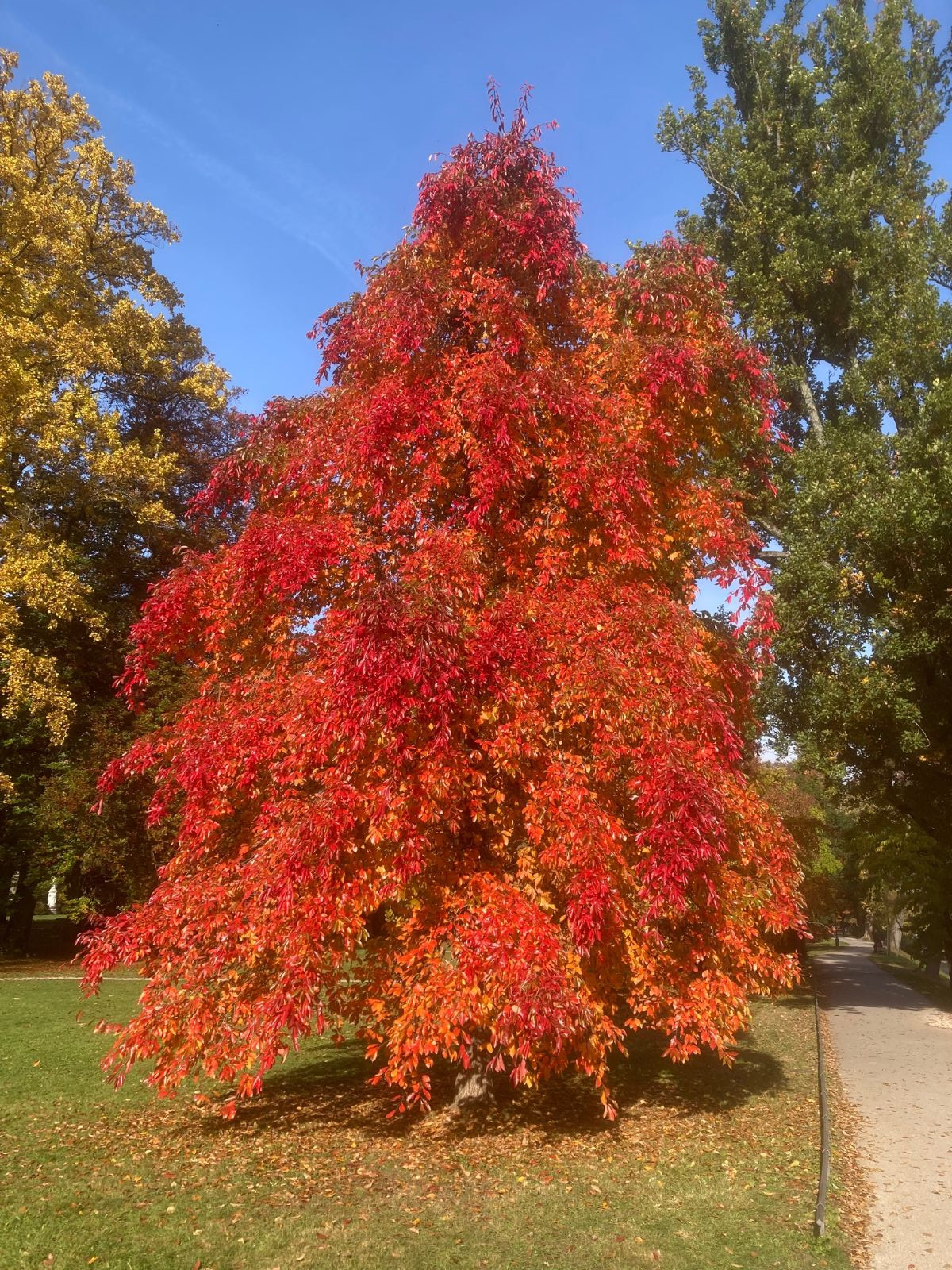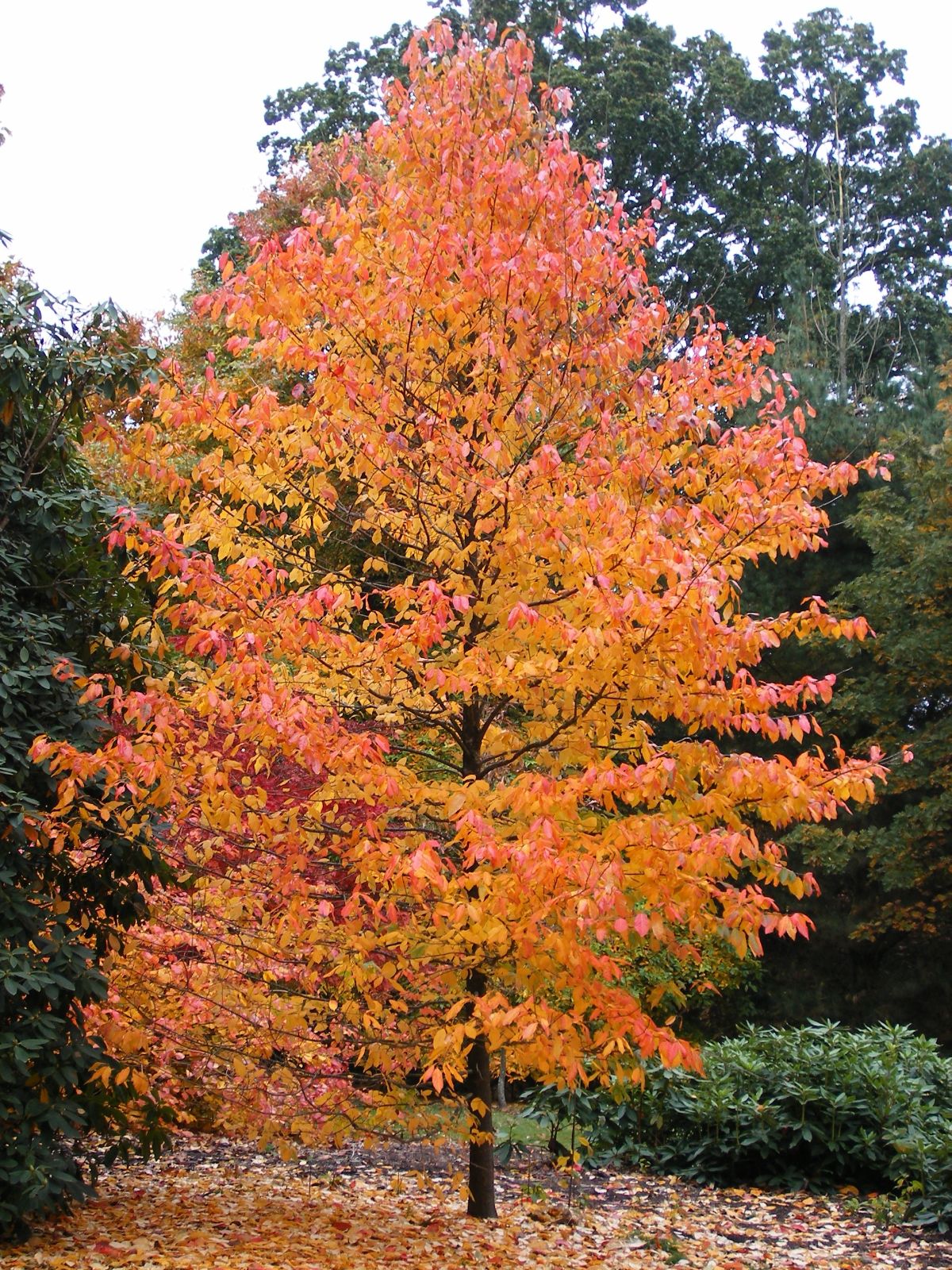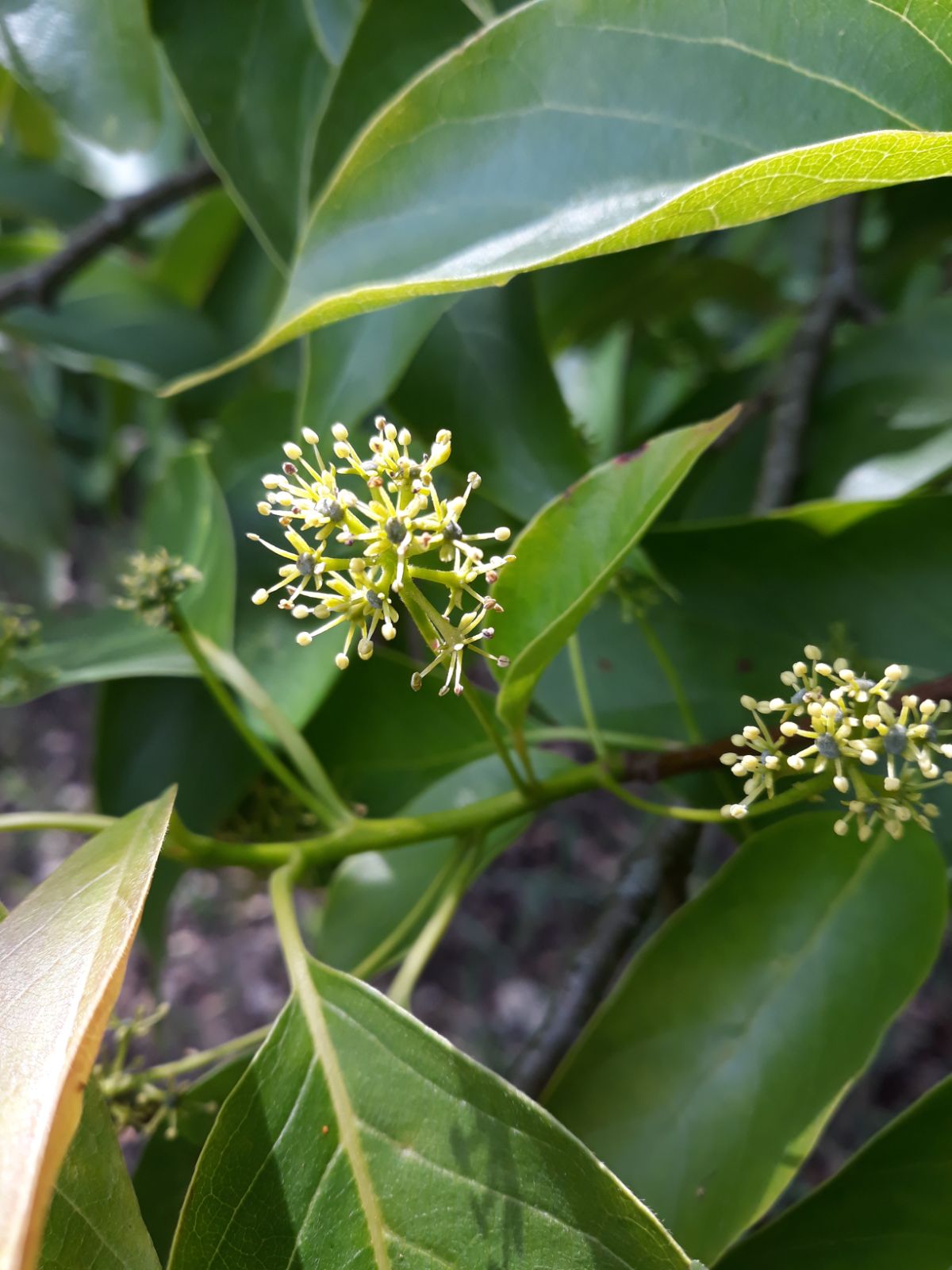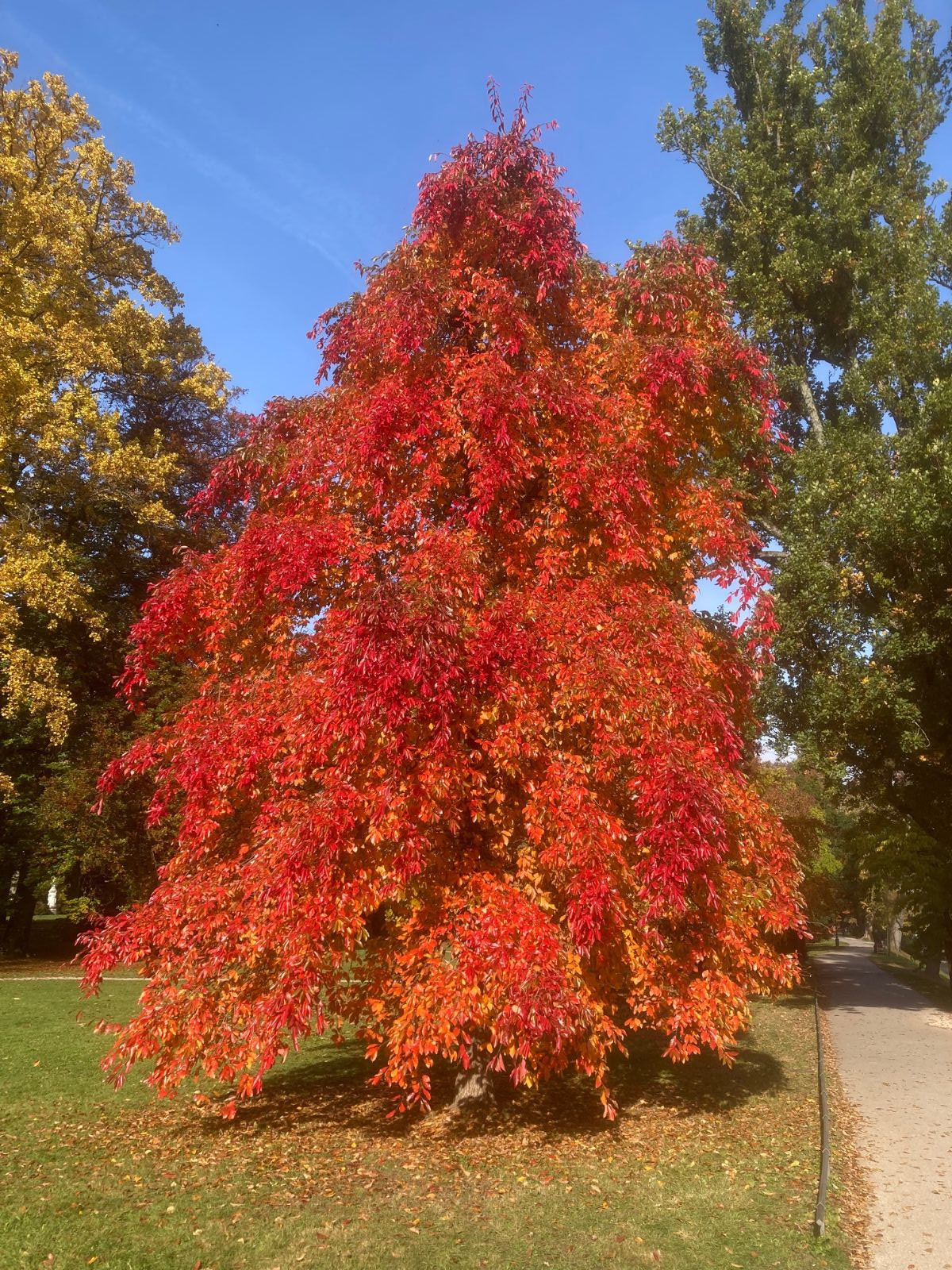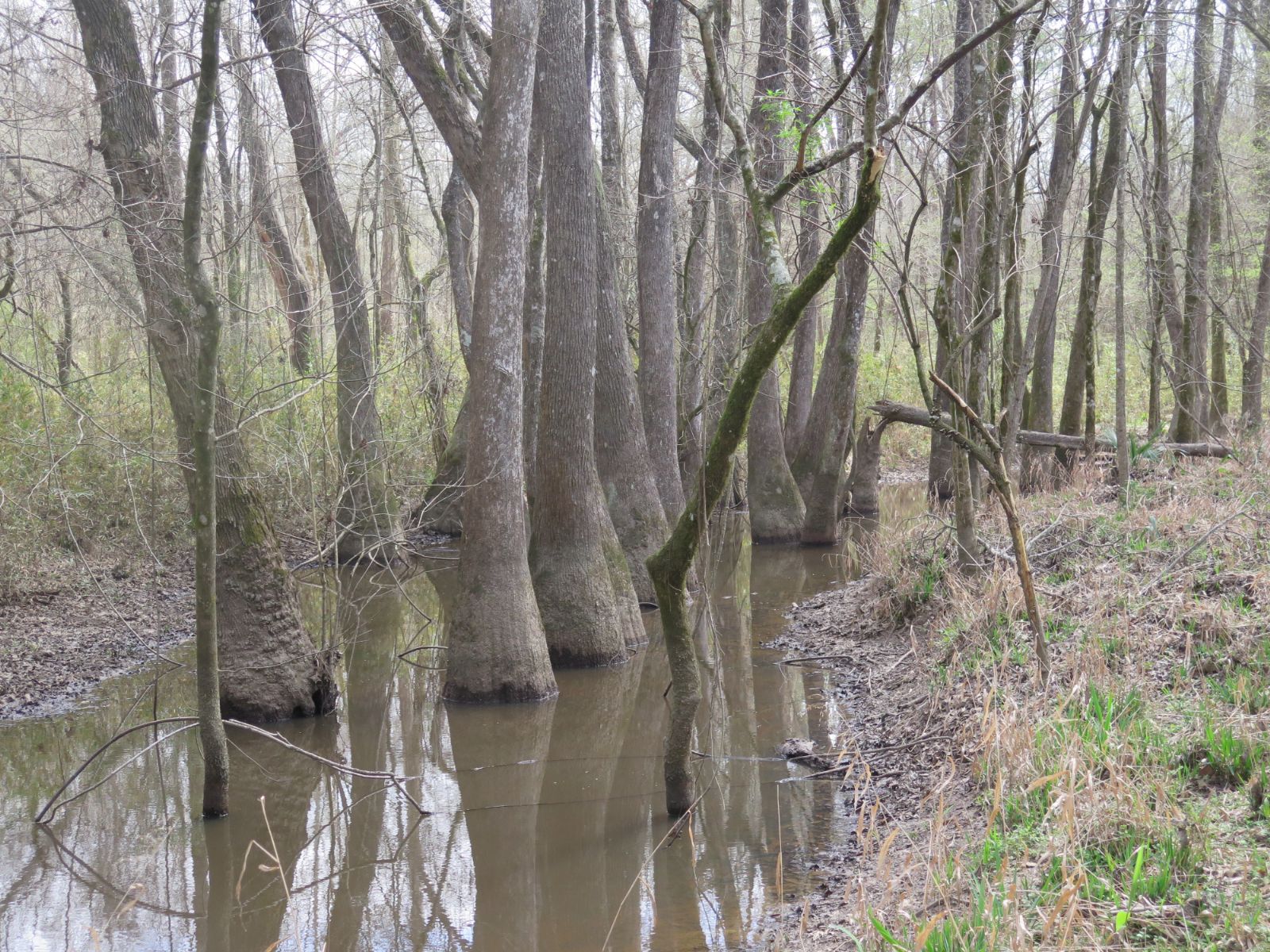Nyssa
Sponsor
Kindly sponsored by a member of the International Dendrology Society.
Credits
Owen Johnson (2021)
Recommended citation
Johnson, O. (2021), 'Nyssa' from the website Trees and Shrubs Online (treesandshrubsonline.
Family
- Cornaceae (formerly Nyssaceae)
Common Names
- Tupelos
- Sour Gums
- Black Gums
Eight species of tree (2 of them sometimes shrubby), adapted to wet conditions. Bark rough in maturity and often rugged. Twigs with chambered pith. Buds alternate or clustered at shoot tips, ovoid to conic, with many scales. The 5 temperate species are deciduous and usually show bright autumn colours; leaves simple, usually elliptic, entire or with a few big teeth; stipules absent. Plants often dioecious; flowers in the axil of a bract with 2 bracteoles, insect-pollinated but not showy. Male flowers are produced on slender-stalked heads or racemes and are typically 5-merous, with 10 stamens. Female flowers, and bisexual flowers when they occur, are solitary or in heads of 2–4; they are (4–)5-merous with an urn-like tubular corolla. Fruit an ovoid or elliptical drupe with a fleshy mesocarp and a woody endocarp; skin yellow, brown, red, purple, black or dark blue; endocarp with several conspicuous longitudinal ridges or papery wings. (Flora of China 2021; Flora of North America 2021; Grimshaw & Bayton 2009).
For the temperate gardener, Nyssa are elegant but slightly anonymous small to medium-sized trees with just one season of glory, when their somewhat glossy leaves, held typically in dense tiers, can assume brilliant gold to scarlet autumn colours. Their flowers in spring are interesting rather than showy, but provide rich sources of pollen and nectar for bees (Exbury Garden 2021); they are followed by quietly colourful fruit, which, in the easiest species to grow, are too sour to eat but can form a useful food-source for wild birds.
All Nyssa are adapted to marshy conditions, and some grow in standing water for much of the year; Linnaeus drew the generic name from that of Nysseides, a water-nymph in ancient Greek mythology, while the vernacular American name ‘Tupelo’ is derived from the native Creek words ito, ‘tree’ and opilwa, ‘swamp’ (Wikipedia 2021). (The alternative names Black Gum and Sour Gum come from association with Liquidambar styraciflua, the Sweet-gum, an aromatic, resin-producing tree from the same parts of the United States that is comparably eye-catching in autumn; Nyssa do not in fact exude any resin and are not aromatic.)
This niche habitat may have contributed to a vague sense that these are rather demanding garden trees; in fact, their adaptation to challenging conditions has resulted in plants that – like the American Swamp Cypress (Taxodium distichum), beside which two Nyssa species naturally grow – are equally able to exploit dry, infertile and badly compacted soils (Zhou et al. 2018). The limiting factor, however, is their need for heat; nealy all Nyssa come from areas with ‘stickily hot summers’ (Grimshaw & Bayton 2009). Nevertheless, as potentially long-lived trees with few natural diseases, the two species with the widest natural ranges (N. sylvatica and N. sinensis) have recently gained in popularity, with N. sylvatica being employed as a street tree in its native North America, and with numerous clones marketed for their tidy habit and exceptional autumn colour. Nyssa are resistant to honey fungus, but in America N. sylvatica in particular tends to be vulnerable to some leaf-spot fungi (Dirr 2009). Saplings also appear palatable to deer (Wikipedia 2021). All the species do seem to be calcifuge and, like most autumn-colouring trees, they put on their brightest show when grown in quite strongly acidic conditions.
Plants are best raised from seed, but, as most individual trees are dioecious, males and females need to grow within pollinating range of one another to ensure viable seed is produced. Cuttings are seldom successful (Grimshaw & Bayton 2009), but branches can be layered (Bean 1976), while cultivars are customarily grafted (Exbury Garden 2021). Individuals of some species sucker freely, which provides another means of propagation. Seedlings grow a long, delicate taproot and are best planted out when small (Dirr 2009).
In their native habitats, many Nyssa are understorey trees, developing attractively dense masses of light-intercepting foliage and thriving in quite dense shade (Zhou et al. 2018). In the gloomier summers of northwest Europe, full sun seems preferred, at least for optimal autumn colour, but Nyssa do still appreciate the side shelter of other surrounding trees. They also enjoy plenty of summer heat; this partiality is least pronounced in the Chinese N. sinensis, but most so in the American N. ogeche, which consequently has never been cultivated very successfully in the United Kingdom or Ireland. In the United Kingdom, a remarkably comprehensive national collection of Nyssa was begun in 2006 by John Anderson, former head gardener at Exbury in Hampshire (Exbury Garden 2021).
Several other species of Nyssa were described from temperate China in the 20th century, while, in North America, N. sylvatica, N. biflora and its subspecies ursina were renamed by successive botanists in almost every possible combination. Recent phylogenetic analyses of the Chinese species by Wang et al. (Wang et al. 2012) and the American species by Zhou et al. (Zhou et al. 2018) have successfully simplified this picture, resulting in the nomenclature that is presented here and that should soon be universally adopted. The temperate species are: in China, N. sinensis Oliver, and in the southern and eastern United States, N. aquatica L. and N. ogeche W. Bartram ex Marshall (these two sharing large fruit) and, with small fruit, N. sylvatica Marshall (whose distribution extends to Mexico) and N. biflora Walter.
Three accepted species are excluded from this site’s coverage, being too tender to survive outdoors in northwestern Europe. These are: Nyssa talamancana Hammel & N. Zamora, described in 1990 from cloud forests in Costa Rica and Panama (Hammel & Zamora 1990); Nyssa javanica Wangerin, with a wide distribution across tropical Southeast Asia; and Nyssa yunnanensis W. Q. Yin, which is assessed as critically endangered and is known only as eight surviving mature trees in the far south of China’s Yunnan province (Wikipedia 2021).
Identification key | ||
| 1 | Bark grey, smooth, then cracking into close scales or plates in maturity; leaves rather deep green, rather shiny beneath, often with distinct, incurving lateral veins: | Nyssa sinensis |
| 1 | Bark grey brown, soon rather deeply and ruggedly fissured; leaves medium green, rather matt beneath; lateral veins often indistinct and never sharply incurving: | 2 |
| 2 | Fruit more than 21 mm long; ovaries hairy; staminate pedicels absent; buds short: | 3 |
| 2 | Fruit less than 15 mm long; ovaries glabrous; staminate pedicels present; buds long and pointed: | 4 |
| 3 | Leaf stalk 30–60 mm; fruit black, blue or purple: | Nyssa aquatica |
| 3 | Leaf stalk 6–20 mm (rarley to 35 mm), fruit yellow to red: | Nyssa ogeche |
| 4 | Leaves usually 5–12 cm long, obovate to broad elliptic; bark with long, regular fissures; female and bisexual inflorescences with 3–8 flowers, rarely 2: | Nyssa sylvatica |
| 4 | Leaves usually 2–7 cm long, oblanceolate to narrowly elliptic; bark irregularly fissured; female and bisexual inflorescences with 1–3 flowers, typically 2; base of trunk swollen in maturity: | 5 |
| 5 | Tree to 30 m, with leaves usually 3–7 cm long: | Nyssa biflora subsp. biflora |
| 5 | Shrub or small tree to 5 m, with leaves usually only 2–5 cm long: | Nyssa biflora subsp. ursina |


